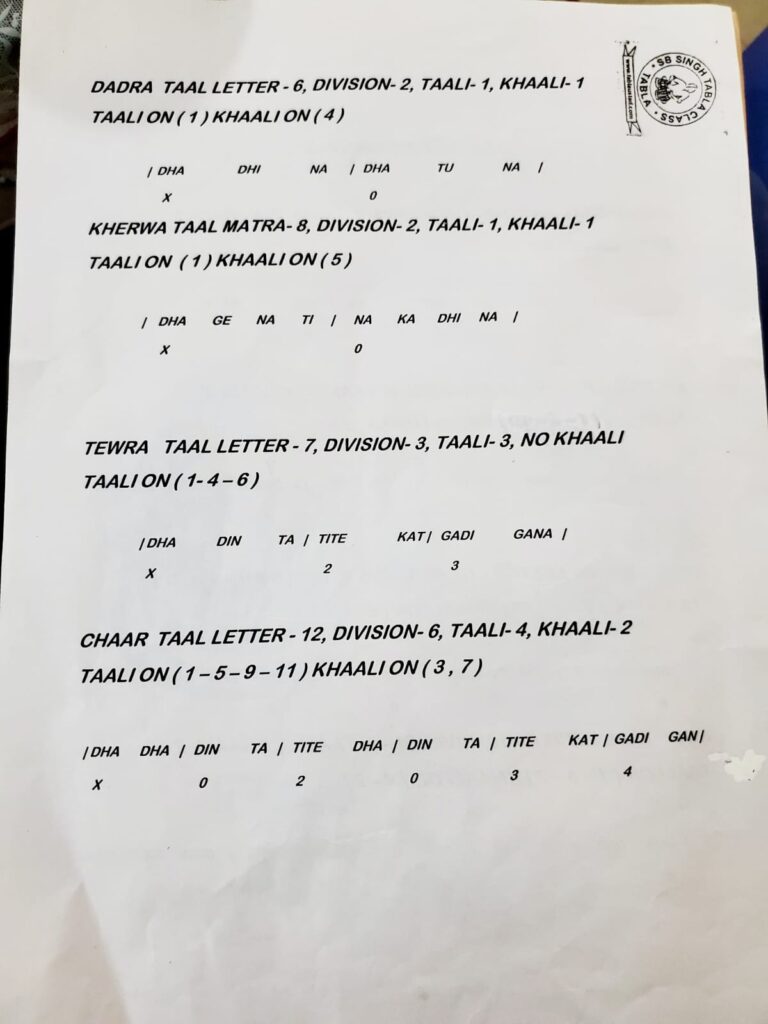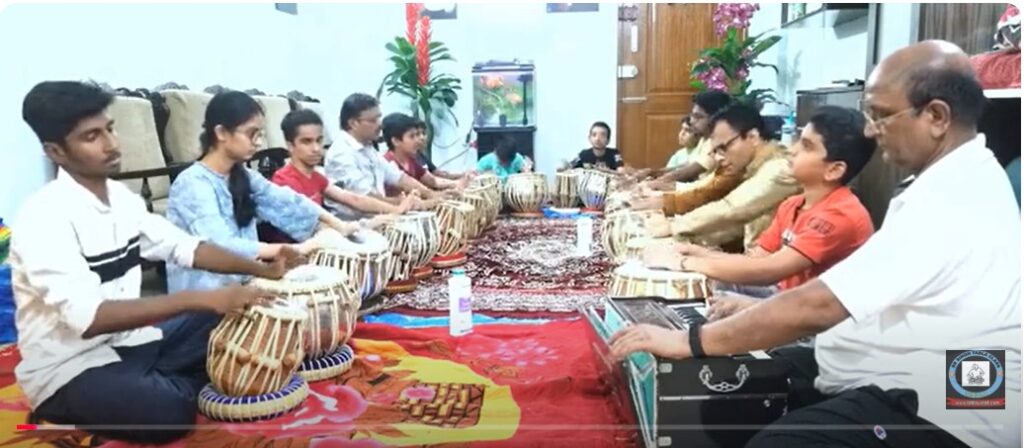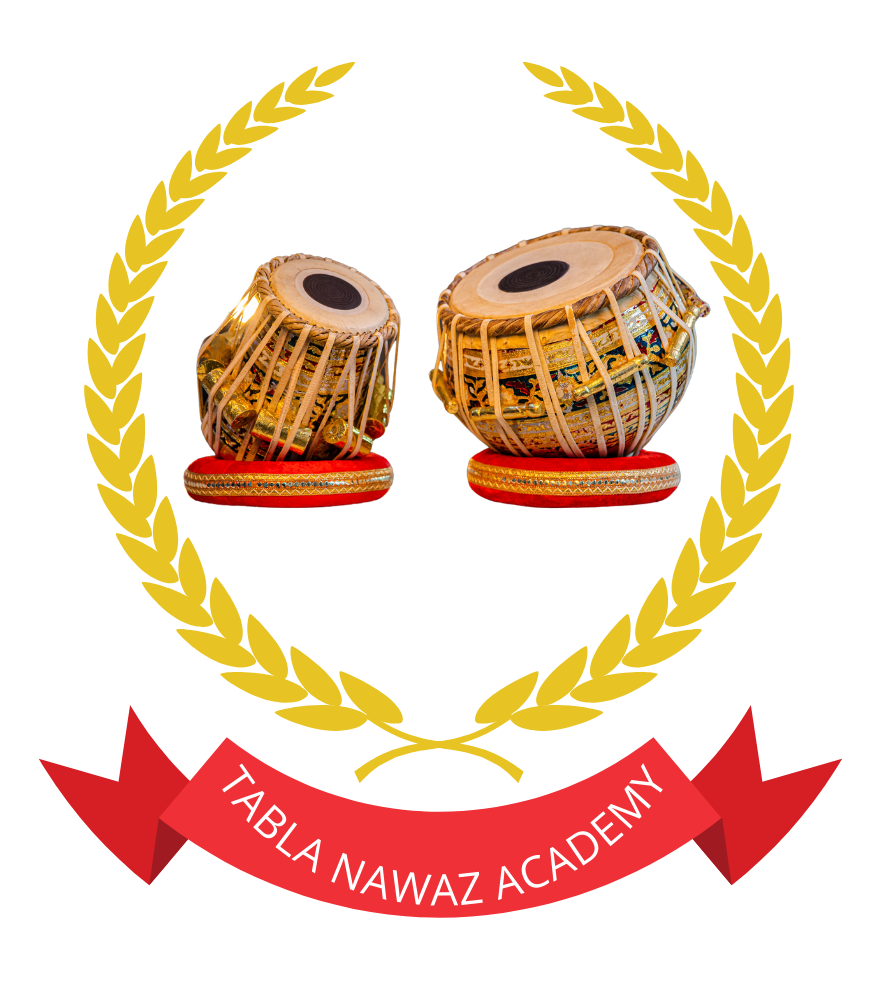The Sangeet Bhushan Part-2 Tabla syllabus for the 2024/25 session is designed to advance students’ proficiency in tabla by introducing more complex rhythmic patterns and compositions. Building upon the foundational knowledge from Part-1, this course delves deeper into the intricacies of tabla performance, emphasizing both theoretical understanding and practical application.
Course Structure
- Theory: This segment focuses on the advanced concepts of Indian classical rhythm, including the
- study of complex taals, their structures, and the historical context of tabla compositions.
- Practical: This section emphasizes hands-on practice, enabling students to master intricate compositions and develop improvisational skills.
Theory Component
Key areas of study include:
- Advanced Taal Structures: In-depth analysis of complex taals such as Rupak (7 beats), Ek Taal (12 beats), Deepchandi (14 beats), Sool Taal (10 beats), Tilwada (16 beats), Teevra Taal (7 beats), Chautaal (12 beats), and Jhaptaal (10 beats). Students will explore their unique characteristics, including divisions (Vibhag), claps (Tali), and empty beats (Khali). Tablanawaz Academy
- Historical Context: Study of the evolution of these taals and their significance in various forms of Indian classical music.
- Notation Systems: Advanced training in the notation systems of Pt. Vishnu Digambar Paluskar and Pt. Vishnu Narayan Bhatkhande, facilitating accurate documentation and interpretation of complex compositions.
Practical Component
The practical segment focuses on:
- Advanced Compositions: Practice of intricate compositions, including advanced Kayadas (structured improvisations), Relas (fast-paced compositions), Gats (fixed compositions), Tukdas (short compositions), and Chakradars (cyclical compositions).
- Taal Mastery: Proficiency in playing the Theka (basic rhythmic pattern) of each prescribed taal, along with complex variations and improvisations.
- Tempo Variations: Ability to perform compositions in various tempos, including Ekgun (single speed), Dugun (double speed), Tigun (triple speed), and Chaugun (quadruple speed), enhancing rhythmic versatility.
Assessment and Evaluation
The evaluation process typically comprises:
- Theory Examination: Written assessments covering advanced concepts of taal structures, historical context, and notation.
- Practical Examination: Performance-based evaluations requiring students to demonstrate proficiency in advanced compositions, accurate rendition of Thekas, and improvisational skills across different taals and tempos.
Learning Outcomes
Upon successful completion of the Sangeet Bhushan Part-2 Tabla course, students are expected to:
- Theoretical Proficiency: Possess a comprehensive understanding of complex taal structures and their applications in various musical contexts.
- Practical Expertise: Demonstrate advanced playing techniques, including the execution of intricate compositions and improvisations with precision.
- Analytical Skills: Analyze and interpret complex rhythmic patterns, facilitating deeper engagement with Indian classical music.
- Performance Readiness: Be prepared for solo and accompaniment performances, showcasing advanced proficiency in tabla.
Conclusion
The Sangeet Bhushan Part-2 Tabla syllabus offers an in-depth exploration of advanced tabla techniques and theoretical concepts, providing students with the skills necessary for professional performance and further academic pursuit in the field of Indian classical music. This course serves as a critical step toward mastery, fostering both technical proficiency and a profound appreciation for the art of tabla.
For detailed information on enrollment and specific course requirements, prospective students should consult official resources or contact accredited music institutions offering this program.
The Sangeet Bhushan Part-2 Tabla syllabus is a well-crafted program aimed at enhancing students’ tabla proficiency. Designed for intermediate learners, this course builds upon the foundational skills acquired in Part-1 and delves into more complex rhythmic patterns, compositions, and theoretical frameworks of Indian classical music. The syllabus emphasizes a balanced approach, combining theoretical knowledge with practical expertise, ensuring students are well-prepared for advanced tabla studies and performances.
Theory Component
The theoretical section of Part-2 introduces advanced rhythmic concepts and expands the learner’s knowledge of Indian classical music. It includes:
- Complex Taal Structures:
- In-depth study of advanced taals such as Rupak (7 beats), Ek Taal (12 beats), Deepchandi (14 beats), Sool Taal (10 beats), Tilwada (16 beats), Teevra (7 beats), Chautaal (12 beats), and Jhaptaal (10 beats).
- Detailed exploration of their divisions (Vibhag), Tali (claps), and Khali (empty beats).
- Understanding the unique characteristics of each taal and its use in different forms of music.
- Notation Systems:
- Advanced training in the Bhatkhande and Paluskar notation systems, enabling students to accurately document and interpret complex compositions.
- Historical Context:
- Study of the origins and evolution of tabla, including the role of taals in Indian classical music and their adaptation in various styles and genres.
- Analysis of Compositions:
- Theoretical understanding of advanced tabla compositions, including their structures and improvisational elements.
Practical Component
The practical portion focuses on hands-on training to master intricate rhythms and enhance performance skills. Key aspects include:
- Advanced Tabla Strokes and Compositions:
- Refinement of basic bols (strokes) and introduction to advanced techniques.
- Practice of Kayadas (structured improvisations), Relas (fast-paced compositions), Tukdas (short rhythmic phrases), Gats (fixed compositions), and Chakradars (cyclic compositions).
- Emphasis on clean articulation and control while performing complex compositions.
- Taal Proficiency:
- Proficiency in playing Thekas (basic rhythmic patterns) of advanced taals with variations.
- Developing improvisational skills for creative rhythmic expressions within the framework of a taal.
- Tempo Mastery:
- Performance of compositions in various tempos, including Ekgun (single speed), Dugun (double speed), Tigun (triple speed), and Chaugun (quadruple speed).
- Accompaniment Skills:
- Techniques for accompanying vocal, instrumental, and dance performances, ensuring seamless synchronization with other art forms.
Assessment and Evaluation
Students are evaluated through a combination of theoretical exams and practical demonstrations:
- Theory Assessment:
- Written exams covering advanced concepts of taals, notation systems, and rhythmic analysis.
- Practical Assessment:
- Performance-based evaluations of Thekas, compositions, and improvisations across various tempos.
- Demonstration of accompanying skills in real-time scenarios.
Learning Outcomes
By the end of this course, students will:
- Have an advanced understanding of tabla rhythms and Indian classical music theory.
- Demonstrate proficiency in performing complex compositions and taals.
- Show enhanced improvisational abilities and creative expression.
- Be prepared to accompany other musicians and perform solo with confidence.
Conclusion
The Sangeet Bhushan Part-2 Tabla syllabus is a vital step for students seeking to advance their tabla skills. It not only hones technical abilities but also instills a deeper appreciation of the instrument’s cultural and musical significance. By mastering advanced taals, compositions, and accompaniment techniques, students are prepared to take on professional and academic opportunities in tabla performance.
https://www.youtube.com/@BhagawanSingh
https://www.facebook.com/sbsinghtablaguru




